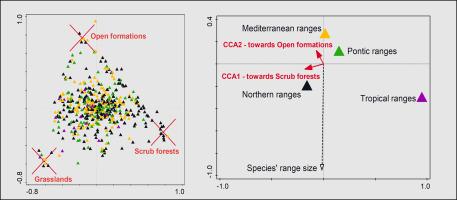昆虫类群的高度多样化表明森林入侵对地中海生物多样性热点地区构成威胁
IF 4.4
1区 环境科学与生态学
Q1 BIODIVERSITY CONSERVATION
引用次数: 0
摘要
地中海盆地代表着全球生物多样性和社会文化热点。目前,传统农牧用地的停止,随之而来的是灌木林对开阔景观的侵占,这可能威胁到当地的生物多样性,这已经在一系列尺度上的几个分类群中得到了早期的记录。这一观点受到了追溯到古代的“地中海森林假说”的质疑,该假说认为这种侵蚀是对原始文化前条件的回归,并具有深远的政策影响,包括支持植树造林,以及在保护规划中忽视非森林栖息地。我们从分布在希腊南部到保加利亚和马其顿北部的150个样地取样了大蛾这一高度多样化的昆虫类群,并对其组成物种(641种,42,136个体)的生物地理特征进行了分析。三种土地覆盖类型——草地、半开放地层、灌丛林——在物种或个体数量上没有差异。飞蛾分布范围小,主要分布于草地和半开放地层,而分布范围广的北方飞蛾主要栖息于灌丛林。这表明,大量地中海盆地特有物种栖息在开阔的稀树草原上,它们可能是在那里进化的;历史上的土地利用允许特有生物群在现代长期持续存在;当前的森林侵蚀和支持景观关闭的政策举措,对多样性和地方性的全球热点构成了直接威胁。本文章由计算机程序翻译,如有差异,请以英文原文为准。

Hyperdiverse insect group indicates forest encroachment a threat to the Mediterranean biodiversity hot-spot
The Mediterranean Basin represents a global biodiversity and sociocultural hotspot. Currently, cessation of traditional agropastoral land use, followed by encroachment of open landscapes by scrub forests, are potentially threatening the endemic biodiversity, which has been earlier documented for several taxa over a range of scales. This view is contested by the “forested Mediterranean hypothesis”, tracked back to antiquity, which considers the encroachment as a return to pristine pre-cultural conditions, and has far-reaching policy implications, including support for afforestation, and neglect of non-forested habitats in conservation planning. We sampled macro-moths, a hyperdiverse insect group, from 150 plots distributed from southern Greece to Bulgaria and North Macedonia, and analysed the material (641 species, 42,136 individuals) with respect to the biogeography of the constituent species. The three land cover categories – grasslands, semi-open formations, scrub forests – did not differ in numbers of species or individuals. Moths with small Mediterranean and Pontic ranges were associated with grasslands and semi-open formations, whereas scrub forests were mainly inhabited by northern species with wide distribution ranges. This implies that substantial numbers of Mediterranean Basin endemics inhabit open savannas in which they probably evolved, that historical land uses allowed persistence of endemic biota long into the modern era, and that the current forest encroachment, and policy initiatives supporting landscape closure, represent direct threats to a global hotspot of diversity and endemism.
求助全文
通过发布文献求助,成功后即可免费获取论文全文。
去求助
来源期刊

Biological Conservation
环境科学-环境科学
CiteScore
10.20
自引率
3.40%
发文量
295
审稿时长
61 days
期刊介绍:
Biological Conservation is an international leading journal in the discipline of conservation biology. The journal publishes articles spanning a diverse range of fields that contribute to the biological, sociological, and economic dimensions of conservation and natural resource management. The primary aim of Biological Conservation is the publication of high-quality papers that advance the science and practice of conservation, or which demonstrate the application of conservation principles for natural resource management and policy. Therefore it will be of interest to a broad international readership.
 求助内容:
求助内容: 应助结果提醒方式:
应助结果提醒方式:


